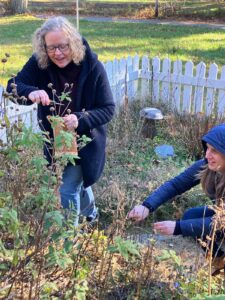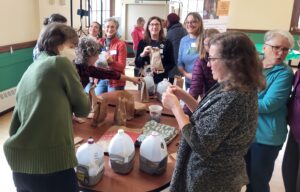I’m not going to lie. These are terrible times for woods and gardens around the world. As I mark my 61st year, my heart is broken for the environments we need that are being destroyed daily around the world. That said, I experienced a renewed glimmer of hope at a recent Winter Seed Sowing workshop at the Tippin’ Rock Farm in Swanzey, NH. Here we shared both native plant seeds and fellowship.
Resilient Native Seeds
It’s true and I’m sure you know how expensive it is to buy native plants. Ironically, many of the showy, 1-gallon, so-called ‘native plants’ we find at the big box stores are actually hybridized, cloned and sterile. These plants may look great their first year but they lack the resilience of straight species and are not as useful to our pollinators and native bees. In contrast, “each seed is a unique individual”, says Heather McCargo, author and founder of the Wild Seed Project. She goes on to explain that by growing native seeds, often gathered from our own gardens, we are expanding the genetic diversity of our native plants and building greater resilience for our natural communities in our changing environment. Our native plants’ seeds don’t need fancy greenhouses to grow. They don’t even need sunshine to sprout. A seed holds everything it needs to create new life inside itself.
Winter Seed Sowing – is a straightforward process of using winter’s weather for the cold-stratification that most native seeds need to sprout without all of the fuss of doing so with our refrigerators. I can’t be the only person who’s found a ‘lost’ ziploc bag with a now-dry paper towel and sad looking seeds at the back of my refrigerator in late spring! Using a recycled plastic container to winter seed sow is very satisfying and if done correctly, provides the grace of not having to guess whether the little green sprout you find inside it in the spring is the plant you want or a random weed that will take over your garden! These seeds sprout outside when the conditions say that it is time.
Gathering to Learn & Grow
There is something particularly wonderful about spending an afternoon with other people who are curious to learn more about and grow native plants that they will add to their own home landscape. We share our desire to bring not only the plants but the interconnected pollinators, and wildlife from the natural places we often visit on the weekends, our beloved woods and fields, into our daily experiences at home.
Even better yet, once we grow a native plant in our landscape, we can, for free, join with other curious homeowners, to register our property into the nationwide, Homegrown National Park (HGNP). This is a grassroots, call-to-action, not-for-profit whose mission is to “regenerate biodiversity and ecosystem function because every human being on this planet needs diverse, highly productive ecosystems to survive.” Started in 2020, today HGNP has over 36-million members and over 112-thousand acres, people just like you and me. HGNP’s initial goal is 20 million acres of native plantings in the U.S, approximately ½ of the green lawns of privately-owned properties. New Hampshire is currently ranked #7 in the nation, with 158 members, and 342 plantings in 264.29 acres. We can choose to step this up!
This winter, in the spirit of New England’s sensible thriftiness, let’s create more hope by winter seed sowing new native plants! Given its low cost and requirements, this is an equal opportunity for many. The effort will provide an exciting spring to look forward to. We’ll be growing, in community, a more beautiful and healthier future to come, sharing and growing seeds of hope.
Join the Keene Public Library and Healthy Home Habitats for a second and free, ‘Winter Native Seed-Sowing in Containers’ workshop at Heberton Hall on Winter Street in Keene, NH on Saturday, December 2 from 1-2:30 PM. We request that you bring a clean, plastic, 1-gallon jug from a food use such as milk, water or juice. Looking forward to meeting you soon!
As published in the Monadnock Shopper News, November 22, 2023
RESOURCES: www.wildseedproject.or
https://map.homegrownnationalpark.org/Plantings/Map, www.healthyhomehabitats.com



